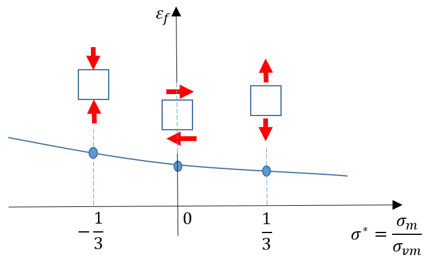/FAIL/JOHNSON |

|

|

|

|
|
/FAIL/JOHNSON |

|

|

|

|
Block Format Keyword
Describes the failure criteria by Johnson-Cook failure model.
(1) |
(2) |
(3) |
(4) |
(5) |
(6) |
(7) |
(8) |
(9) |
(10) |
/FAIL/JOHNSON/mat_ID/unit_ID |
|||||||||
D1 |
D2 |
D3 |
D4 |
D5 |
|||||
|
Ifail_sh |
Ifail_so |
|
|
Dadv |
|
Ixfem |
||
(1) |
(2) |
(3) |
(4) |
(5) |
(6) |
(7) |
(8) |
(9) |
(10) |
fail_ID |
|
|
|
|
|
||||
|
In these two simple examples, strain rate and temperature are not considered. The stress-strain relationship could be simplified, as below:
![]()
With three typical loadings (example: pure tension, pure shear or pure compression) material parameter D1, D2 and D3 could be determined using the above simplified stress-stain relationship.

Example 1: use Ixfem=0, if the element deleted reaches the rupture criteria.
Example 2: use Ixfem=1, if the element cracked reaches the crack criteria.
#RADIOSS STARTER #---1----|----2----|----3----|----4----|----5----|----6----|----7----|----8----|----9----|---10----| /UNIT/1 unit for mat # MUNIT LUNIT TUNIT Mg mm s #---1----|----2----|----3----|----4----|----5----|----6----|----7----|----8----|----9----|---10----| #- 1. MATERIALS: #---1----|----2----|----3----|----4----|----5----|----6----|----7----|----8----|----9----|---10----| /MAT/PLAS_JOHNS/1/1 Steel # RHO_I 7.8E-9 # E NU 210000 .3 # a b n EPS_p_max SIG_max0 270 450 .6 0 0 # c EPS_DOT_0 ICC Fsmooth F_cut Chard 0 0 0 0 0 0 # m T_melt rhoC_p T_r 0 0 0 0 /FAIL/JOHNSON/1/1 # D1 D2 D3 D4 D5 0.11 0.08 -1.5 0 0 # EPS_0 Ifail_sh Ifail_so Dadv Ixfem 1 1 1 0 0 #---1----|----2----|----3----|----4----|----5----|----6----|----7----|----8----|----9----|---10----| #enddata #---1----|----2----|----3----|----4----|----5----|----6----|----7----|----8----|----9----|---10----| |
#RADIOSS STARTER #---1----|----2----|----3----|----4----|----5----|----6----|----7----|----8----|----9----|---10----| /UNIT/1 unit for mat # MUNIT LUNIT TUNIT Mg mm s #---1----|----2----|----3----|----4----|----5----|----6----|----7----|----8----|----9----|---10----| #- 1. MATERIALS: #---1----|----2----|----3----|----4----|----5----|----6----|----7----|----8----|----9----|---10----| /MAT/PLAS_JOHNS/1/1 Steel # RHO_I 7.8E-9 # E NU 210000 .3 # a b n EPS_p_max SIG_max0 270 450 .6 0 0 # c EPS_DOT_0 ICC Fsmooth F_cut Chard 0 0 0 0 0 0 # m T_melt rhoC_p T_r 0 0 0 0 /FAIL/JOHNSON/1/1 # D1 D2 D3 D4 D5 0.11 0.08 -1.5 0 0 # EPS_0 Ifail_sh Ifail_so Dadv Ixfem 1 1 1 0.5 1 #---1----|----2----|----3----|----4----|----5----|----6----|----7----|----8----|----9----|---10----| #enddata #---1----|----2----|----3----|----4----|----5----|----6----|----7----|----8----|----9----|---10----| |
Where,
T* is computed in the material law, if this one is thermo plastic, like /MAT/HYD_JCOOK (LAW4). Two XFEM options are available: mono-layer and multi-layer. The XFEM option depends on the property type associated to the failure criterion applied to the material identifier:
In this case, the whole element thickness is considered as a single layer. The failure criterion is calculated in each integration point, but only one single crack can appear in this element. This approach is compatible with all values of the shell flag (Ifail_sh=1 or 2). The crack direction is determined by the principal constraints in the last failed integration point.
In this case, each integration point over thickness is considered as a distinct layer. The failure criterion is calculated separately and the crack direction may be different in each layer. Crack direction in each layer will independently propagate from one element to another. Multi-layer XFEM is not compatible with Ifail_sh=1. Its value will be automatically set to Ifail_sh=2 in this case. c) If /PROP/TYPE51 is used, then multi-layer XFEM will be applied and the separate cracks may appear in each layer and propagate independently from one element to another. Thus, crack directions and patterns will be different in each layer. The failure criterion is calculated separately in each integration point and crack will propagate when all the integration points fail within a layer. Multi-layer XFEM is not compatible with Ifail_sh=1. Its value will be automatically set to Ifail_sh=2.
- Element rupture (deleted) if D > Dfail with Dfail=1
- Element cracked, if: D > Dfail with Dfail=1, if this element has no failed neighbors. So in this case use Dfail=1 for new crack initialization. D > Dadv if this element has failed neighbors. Dadv will be used if existing crack arrives to a boundary of an element. So in this case use Dadv for crack advancement. - Element deleted, if a second crack arrives to the same element where,
Dadv should always be less than 1 (Dfail =1) (Dadv < Dfail=1). If not, then Dadv is set to 1 (Dadv=Dfail=1). |
See Also:
Failure to Element/Material Compatibility